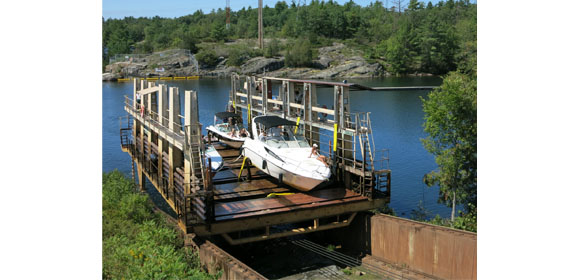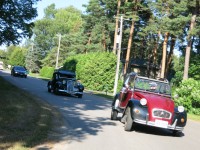CAC Muskoka Summer Outing to Big Chute Marine Railway – Aug. 24, 2013

by George Dyke…
August has been a record month of minimal rainfall. (Unlike July which was the wettest on record but with many sunny days like the one for our Niagara Wine Tour). For the past 4 years we have celebrated the hot, hazy August weather with a pool party. However this year we decided that rather than relaxing in a backyard, we would get behind the wheel and do a serious day of driving, heading up to Muskoka with our primary destination being the Big Chute Marine Railway.
 See our full photo gallery here.
See our full photo gallery here.
We met just off HWY 400 in Vaughan, ON enjoying coffee and muffins at McDonalds as people began to drift in. Participants included; Larry Lewis, Lloyd McBride, Roland Voegele, Raj & Divia Raja, Angus MacDougald and his brother Ian who was visiting from France, Marijke Dyke and me. George Klein and Nazar Mishchuk made the trek to see us off, and even though they had other commitments for the day joined us for the beginning part of the drive north on HWY 400. Particular credit has to be given to Nazar who drove his 1939 Traction Avant 7A all the way to Barrie, the first highway outing it has had since he began restoration on it two years ago.
Once we got north near Georgian Bay, we exited HWY 400 and took Big Chute Rd from Coldwater through a lovely twisty terrain of lakes and rock outcrops to the Marine Railway.
Big Chute Marine Railway is a boat lift at lock 44 of the Trent-Severn Waterway. It works on an inclined plane to carry boats in individual cradles over a change of height of about 60 feet (18 m). It is the only marine railway (or canal inclined plane) of its kind in North America still in use and is operated by Parks Canada.
The original Big Chute Marine Railway was completed in 1917, and could only carry boats up to 35 feet (11 m) long, preventing navigation by large commercial vessels. In 1923 the original marine railway at Big Chute was replaced, as the size and number of boats had increased, with the second carriage being able to carry boats up to 60 feet (18 m) long. The 1923 carriage was used up until around 2003, on days of extremely heavy traffic, or as a backup for the new carriage. Although the old carriage is no longer used, it remains on display.
In the 1960s surveys of the area were done and plans were made for a single lock at Big Chute. Several impractical ideas were suggested, but no practical solution could be found. By the end of the 1960s the old marine railway could not keep up with the amount of boating traffic in the area. Long lines formed at either end of the railway, with waits often being overnight. The current marine railway came about as result of the sea lamprey, which had been devastating the fishing industry in the Great Lakes. Sea lampreys were found in Gloucester Pool at the bottom of the railway.
Research was done to find a way to prevent the migration of the sea lamprey into Lake Couchiching and Lake Simcoe, while still effectively increasing the flow of traffic. A biologist sat at the bottom of the railway for days, checking the bottom of boats going through, and finally saw a lamprey attached to the bottom of a boat. The lamprey fell off after less than 6 meters, so the railway was determined to be effective at preventing the sea lamprey’s migration. In 1976, it was finally decided that a new, enlarged railway would be built. The current carriage was opened to the public in 1978, and can carry a boat up to 100 feet (30 m) long and 24 feet (7.3 m) beam. (The old system has been decommissioned by Parks Canada, to conform with modern safety standards,
although the old tracks and carriage still remain.)
Boats are floated into the cradle, which is approximately 80 feet (24 m) long by 26 feet (7.9 m) wide. Four 200 horsepower (150 kW) electric motors provide traction by cable. It can transport up to a combined total of 100 short tons (91 t) in weight. The marine railway structure is on a dual track which keeps the carriage level (the front wheels are on a different track than the back wheels, with the front of the carriage on the upper tracks). Boats rest on the bottom of the carriage, and webbing slings are provided to support boats safely and prevent them from tipping.
Quite fascinated with the engineering we pressed on with our drive, heading west and taking HWY 400 south a short distance to Severn Falls where we stopped for lunch at the Driftwood Cove Cafe. It’s a lovely, informal place with excellent food and an enclosed patio that overlooks the marina. After lunch we headed north up HWY 400 exiting at Hwy 38 and driving east to Bala. From there we headed north on HWY 169 to Glen Orchard and turned right on to 118 heading toward Port Carling and onto Bracebridge.
At Bracebridge we headed south on 118 (Wellington St.) and as we headed out of town, turned right on Muskoka Beach Rd stopping in the Muskoka Brewing Company to sample a few of their rather fine brews before heading down to Gravenhurst on one of the nicest roads roads to drive in Muskoka.
From Gravenhurst we drove south to Orillia on HWY 11 and then followed the shoreline road along the south side of Lake Simcoe as far as Barrie. Once at Barrie we traveled back down HWY 400 to Toronto.
Not all our events entail as much driving, but the day we had for this one was absolutely perfect. Traffic was light and we got to enjoy some backroads of Ontario that felt as though they were made specifically to
be enjoyed in a Citroën.
Return to Citroën Autoclub Canada Past Events page
